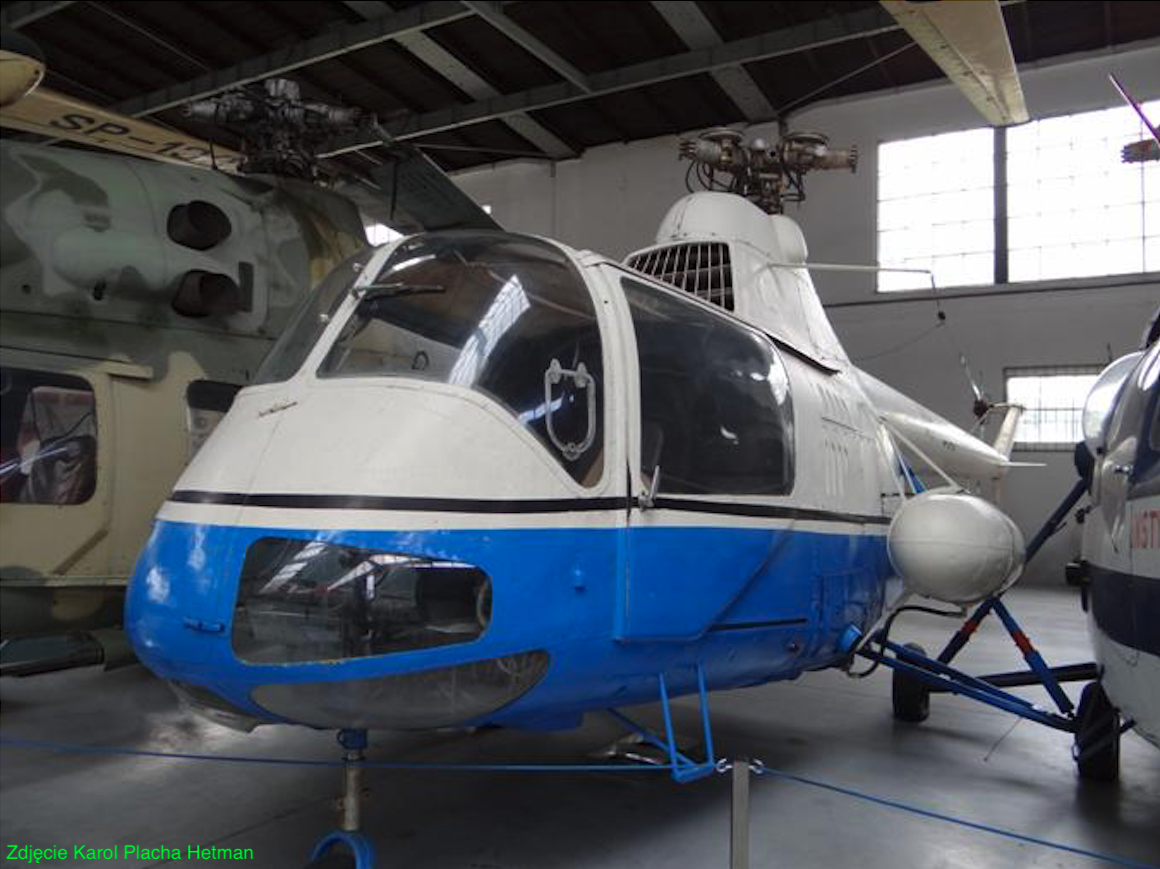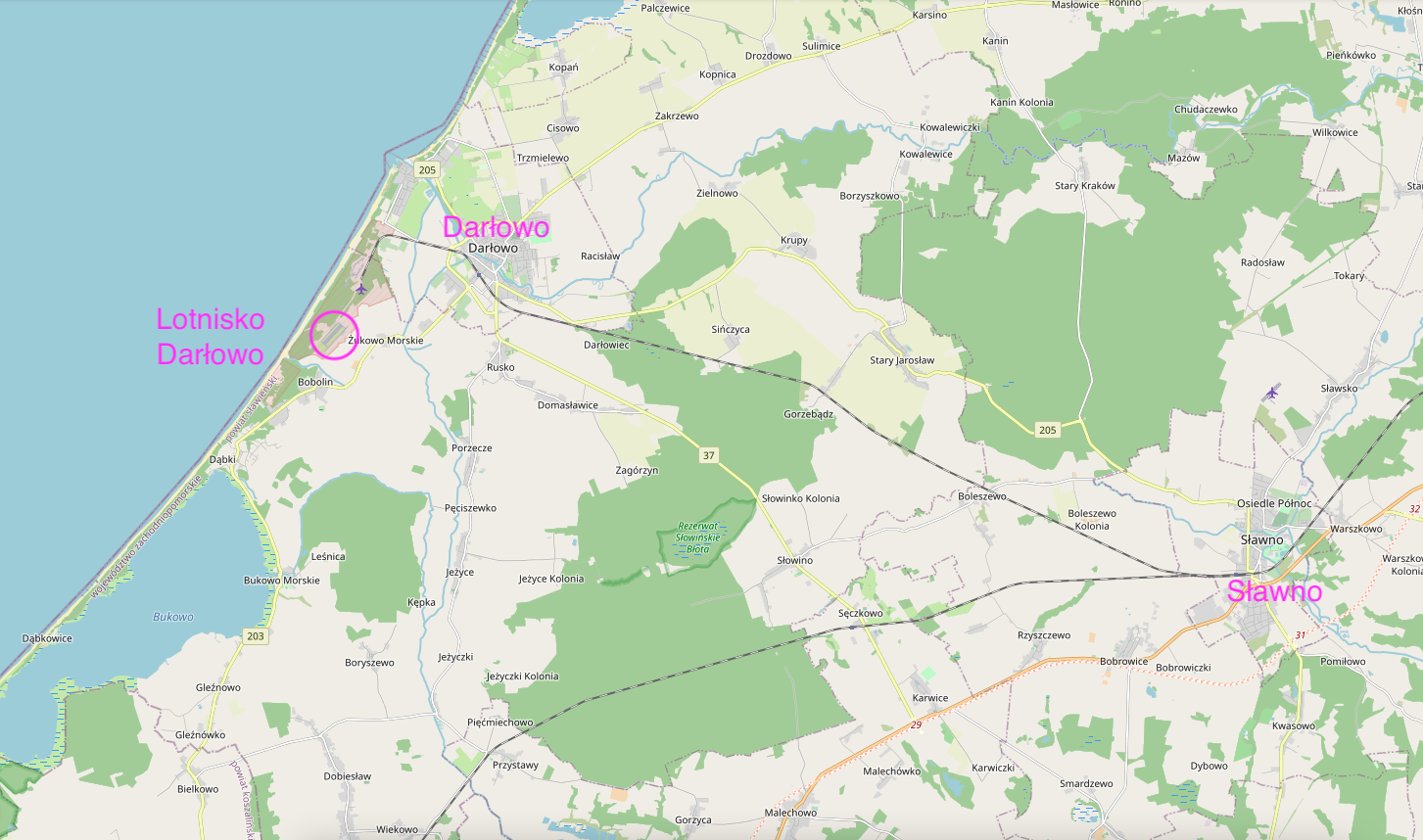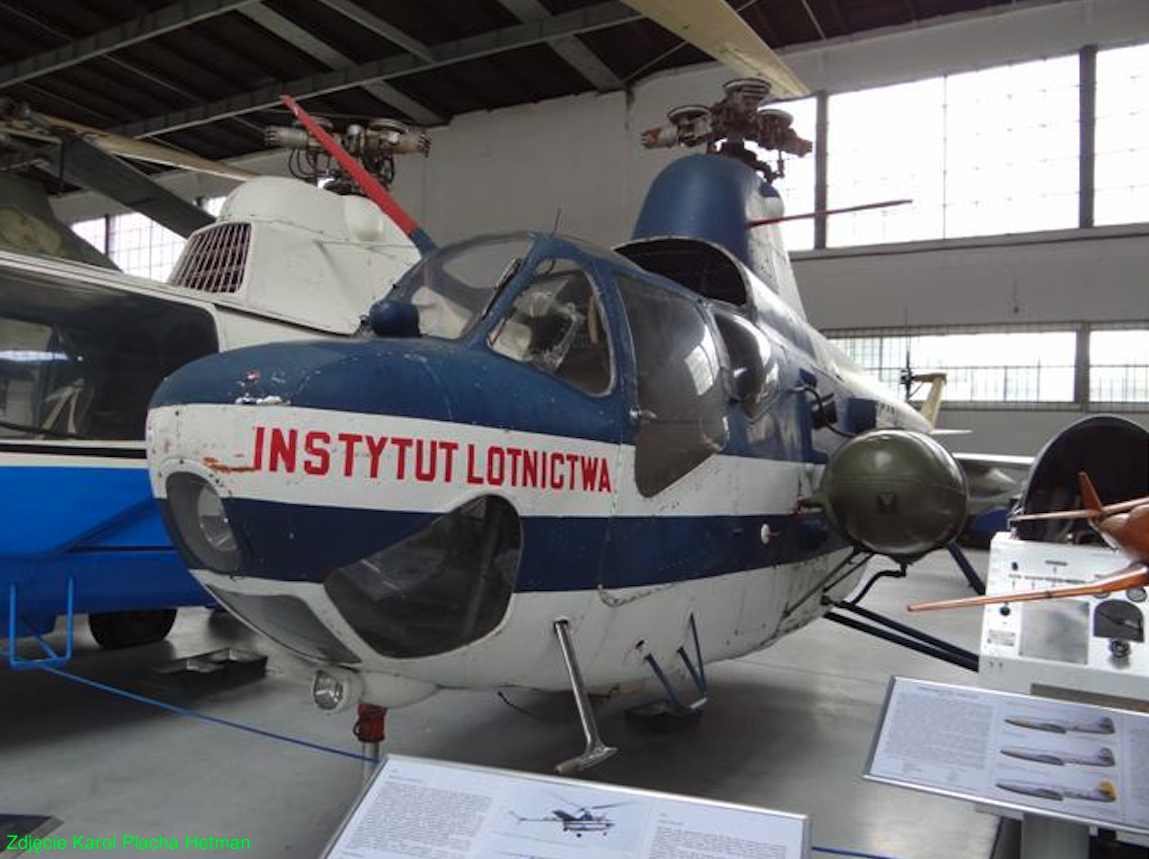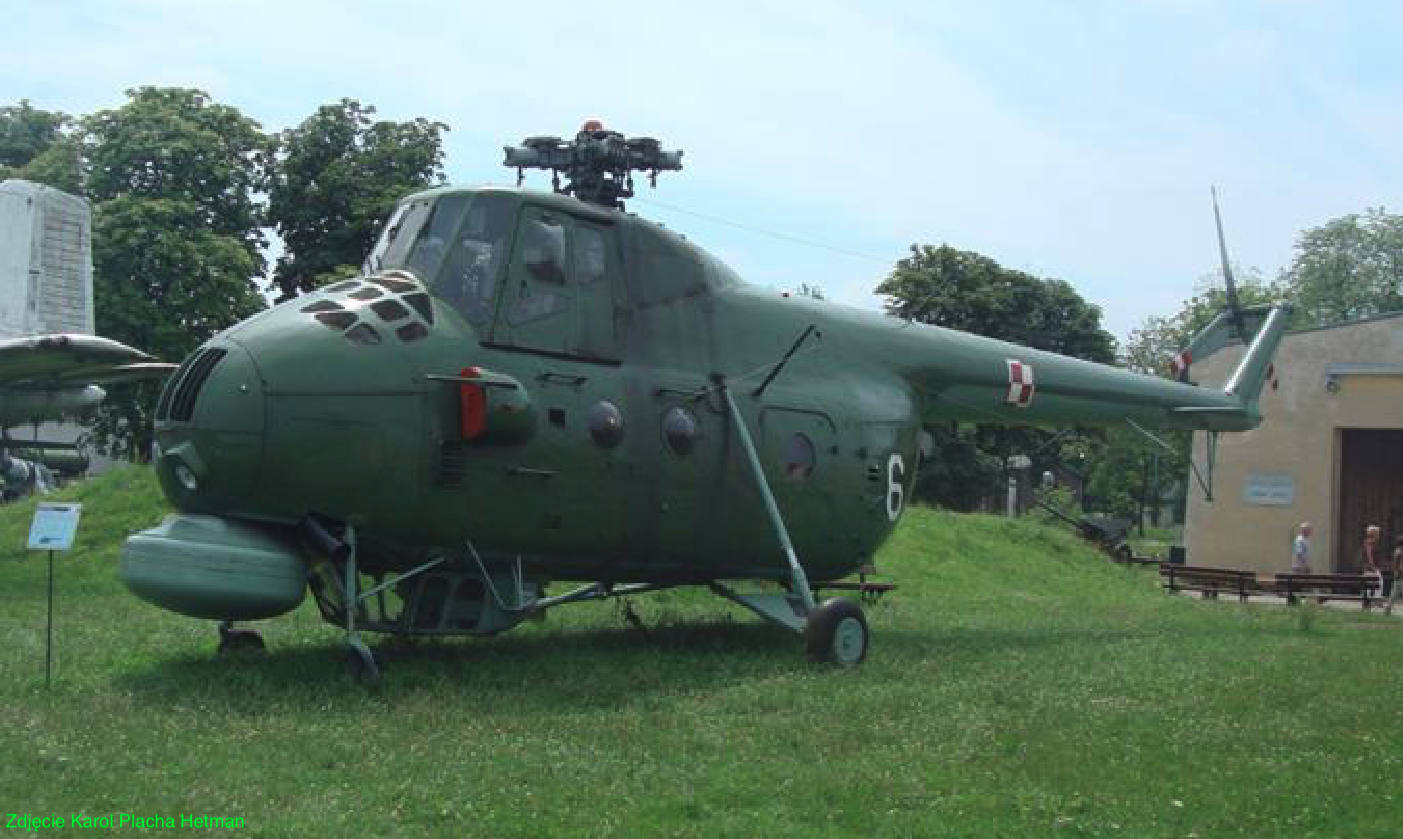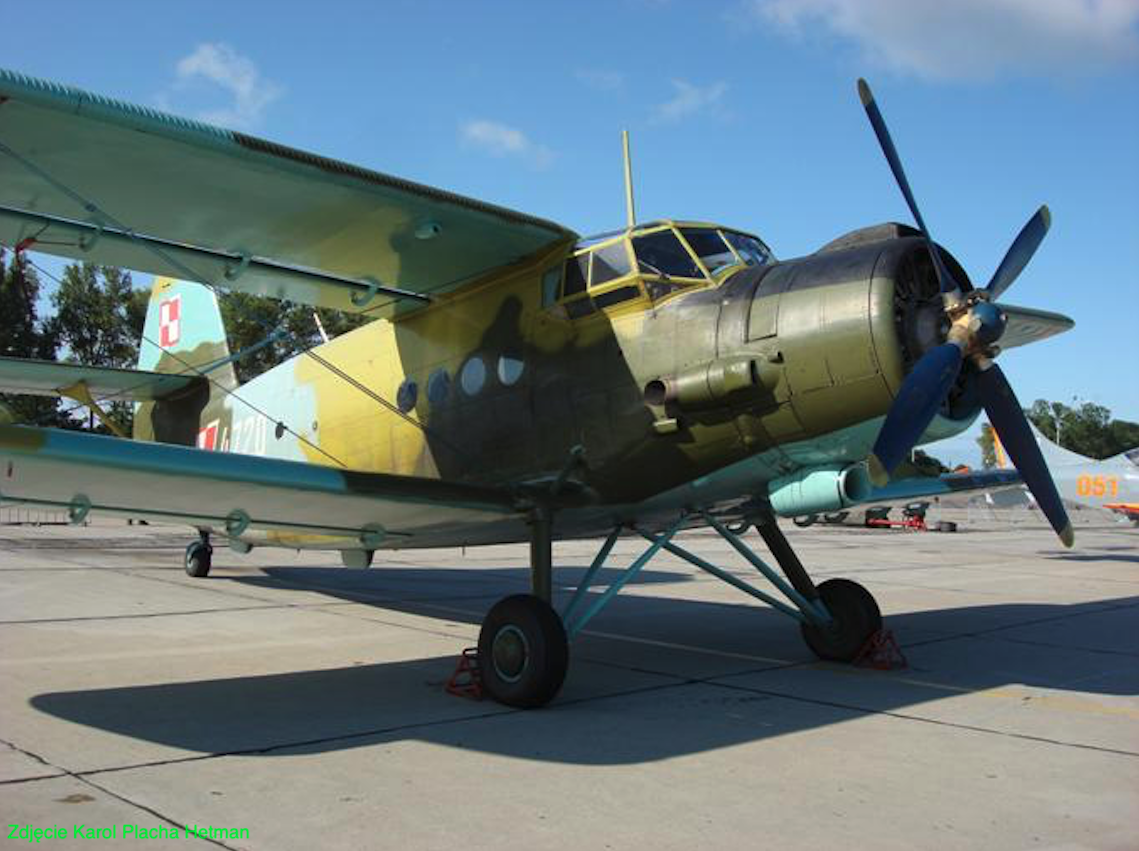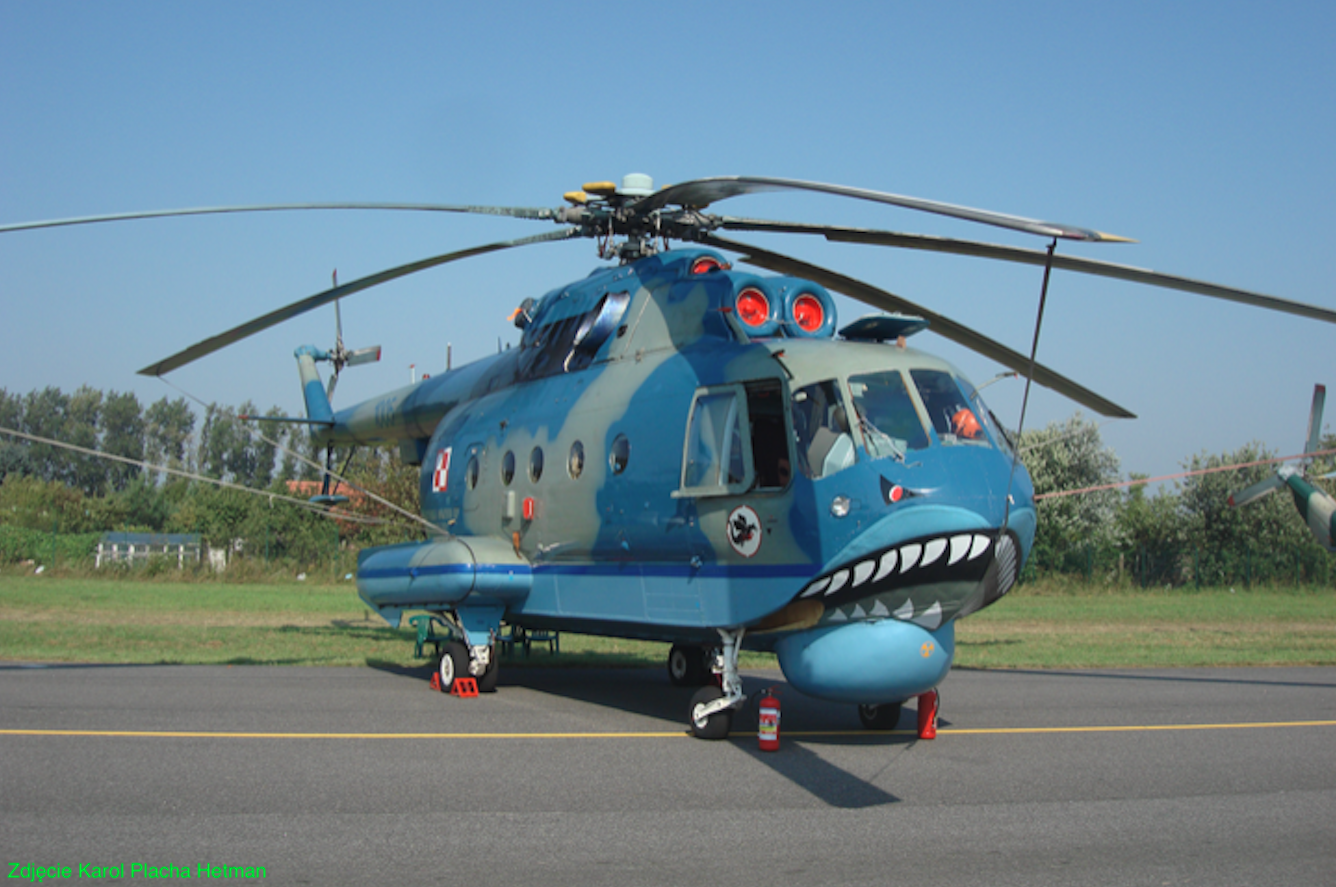Darłowo 2012-06-20
Darlowo airport.
Geographic coordinates: 54.405N 16.353E.
Airport in Darłowo.
In 2010, Darłowo Airport was part of the structures of the 44th Naval Aviation Base, which also had Babie Doły Airport and Siemirowice Airport under its command. Darłowo Airport, although it was used by the Polish Navy, performed typical police and SAR tasks in the Baltic Sea. It was also open to GA traffic. Darłowo Airport is one of those airports in the Republic of Poland that were not threatened with liquidation, despite the disappearance of military features. There was a proposal to transfer the Darłowo Airport to the structures of the Ministry of the Interior. Darłowo airport is very specific and has no equivalent in the entire Republic of Poland. Despite being located in an old militarized area, the airport itself is modern and capable of accepting modern helicopters that Poland could buy.
At the turn of 2010 and 2011, naval aviation underwent another restructuring. Functioning as independent units of the squadron, they were incorporated into the structures of naval aviation bases. Since January 1, 2011, two units have been subordinated to the Command of the Gdynia Aviation Brigade of the Polish Navy: the 43rd Naval Aviation Base in Gdynia Babie Doły. 44. Naval Aviation Base in Siemirowice and Darłowo.
The Gdynia Naval Aviation Brigade (BLMW) is an organizational union of the maritime branch of the armed forces, i.e. the Polish Navy. There are currently three units in the brigade structure: the Gdynia Aviation Brigade Command, the 43rd Naval Aviation Base (43 BLotM) and the 44th Naval Aviation Base (44 BLotM). BLMW planes and helicopters are stationed at the airports in Gdynia Babie Doły, Siemirowice and Darłowo. To be precise, the 44th Naval Aviation Base has two airports in its structures: Siemirowice Airport, which is based mainly on aircraft, mainly PZL M-28 Bryza, for various purposes, and Darłowo Airport, on which mainly helicopters of various types are based.
History of Darłowo Airport.
The area included in the triangle between the towns; Darłowo, Darłówko and Dąbki, from the 19th century, served various military functions. This was due to its convenient location on the coast of the Baltic Sea. It was similar in the area of Ustka and Kołobrzeg. A special flourishing of the military area took place after the bandit Hitler came to power in Germany. The German army, preparing for the Second World War, organized a training ground for artillery forces near Darłowo. Among other things, large, long-range guns were tested on it. Already during the war, a German railway artillery squadron was created here. For the purposes of the operation of these units, an airstrip was organized here, which became part of the network of coastal airstrips. They occurred along the entire length of the coastline, from Szczecin to Królewiec.
After the Second World War, by the decision of the greats of this world, Pomerania came under the administration of Poland. Almost all military facilities located on the coast were occupied by Muscovites. They exploited them in a robbery manner, and being not interested in their further exploitation, they gradually handed them over to the Polish Army. Military facilities in the vicinity of Darłowo came under the administration of the Polish Army only in 1947. In 1948, the Railway Artillery Squadron of the Navy was stationed here, which was formed in Oksywie.
In 1950, by order of the Ministry of National Defense of August 8, 1950, the 5th Battalion of the Railway Forces (JW 2224) was formed in Darłowo, subordinate to the Command of the Land Forces of the People’s Republic of Poland. The newly created battalion took over the former German barracks. In 1955, the battalion was disbanded. The staff of the disbanded unit was sent to the remaining battalions of the railway troops, and the facilities in Darłowo returned to the care of the Polish Navy.
The second half of the 1950s was a period of intensive introduction of helicopters into operation. They could perform tasks inaccessible to airplanes. Therefore, it was decided to equip the Polish Navy with helicopters. However, the difficult economic situation of Poland resulted in postponing this intention. As a result of another reformation in the Military Aviation in 1962, on August 23, 1962, the Chief of the General Staff of the Polish Army issued an order under which the commander of the Navy (MW) was ordered to form the 28th Rescue Squadron of the Polish Navy, on the post no. 35/413 from 121 soldiers and 1 civilian employee. Darłowo Airport was chosen as its stationing site. The squadron is equipped with not the newest SM-1 and SM-2 helicopters. This is how Darłowo’s aviation history began, which continues to this day.
It was already known and confirmed at that time that the operation of aircraft in the coastal zone poses additional problems. The wind blowing from the sea brings tiny drops of sea water that contain a significant concentration of salt. This salt is very harmful to the metal structure of aircraft and their electronics. Therefore, Darłowo Airport was treated as a temporary solution. But time has shown that the advantages of the location outweigh the increased requirements for the maintenance of the flying equipment.
Railway to Darłowo.
In 1978, during the German times, the Korzybie – Darłowo railway line was launched, with a length of 39 km. In Poland, this line received No. 418. The first train crossed this route on November 15, 1878. After World War II, freight and passenger traffic was restarted on this route. There were stations on the trail: Korzybie – Zawistowo – Sławno – Nowy Jarosław – Sińczyca – Darłowo. The Sławno railway station is important because the railway line No. 202 runs through it, connecting Gdańsk and Stargard Szczeciński. Military trains also used route No. 418. From the railway station in Darłowo, the track continues south-west and is a military track that leads directly to the airport and other military facilities. This track is about 5 km long and has numerous side tracks with loading yards.
Line No. 418 has always been single-track and non-electrified. It runs through forests, meadows and wastelands with long straight sections. The track speed was 80 km/h. In 1991, passenger traffic was stopped on line No. 418. In 1997, the Korzybie – Sławno section was demolished. The former subgrade became dirt roads. In 2001, due to the poor condition of the tracks, freight traffic between Sławno and Darłowo was stopped. In 2002, the track was renovated and the track speed increased to 100 km/h. The renovation was financed by the Ministry of National Defense. Freight traffic has been restored. In 2005, passenger traffic was restored on the Sławno – Debrzno route, but already in 2012, passenger traffic was closed again. In the summer of 2017, passenger traffic was resumed, and due to the great interest, it was restarted in the summer of 2018. After that, passenger traffic was resumed all year round. In 2018, 13,200 passengers were transported. The route is serviced by modern rail buses. An interesting fact is that in Darłowo, through the railway crossing on ul. Aleja Wojska Polskiego, car traffic is stopped by a railway worker.
The road to Darłowo.
Darłowo can be reached by the following roads: National Road No. 37 (this route connects the center of Darłowo with the DK6 road near Karwice), Provincial Road No. 203 (this route connects Koszalin with Ustka), Provincial Road No. 205 (this route connects Darłówko – Darłowo – Sławno and further to Bobolice).
Military complex.
It is worth writing a few sentences about the entire military complex hidden in the forests of the coastal belt between Darłowo-Darłówek and Dąbki. This area stretches for about 6 km, and the width of the forest does not exceed 1,000 m at its widest points. The entire area is about 3,600 hectares. From the sea, the border is the dunes of the beach. On the land side, the forest is adjacent to wasteland, and the whole area is closed by the Provincial Road No. 203. The basic infrastructure of this area was the German fortifications in the form of numerous, mostly unused bunkers, which fronts are directed towards the Baltic Sea. The military complex begins at the intersection of today’s Zwycięstwa and Lotników Morskich streets. Here is the main entrance gate to the current military unit of JW. 4653 Darłowo, i.e. the 44th Naval Aviation Base of the Polish Navy (from January 1, 2011).
The oldest part of the barracks and headquarters was completed at the beginning of the 1940s. In addition to barracks and staff buildings, it received full social and living facilities, including warehouses, stables, sports fields and a physical education training ground. It occupied an area of 18 hectares.
Moving towards the south-west, there is another complex consisting of nine buildings erected during the Second World War. During the times of the People’s Republic of Poland, two more buildings were built. Originally, it was a complex for another military unit.
Another object is the airport, which is now called the helipad from which helicopters operate. It functions as a technical base for the 44th Naval Aviation Base – Darłowo. The landing site was established during the German times in the center of the forest, by clearing it on an area of 10 hectares. During the times of the Polish People’s Republic, its area increased to 15 hectares. The maximum length is 600 m and the width is 250 m. For the needs of helicopters, the landing area has been equipped with two heliports, taxiways and stands. All with a concrete surface. There are several hangars on the landing pad.Moving further to the south-west, we come across a warehouse complex. A characteristic object here is a radar station. The current station is a Polish construction and production radar; AVIA-W, which was installed here in 1982.
Another military complex is Darłowo Airport. Its construction began in 1963. The reason was the narrowness of the landing site, the expansion of which was impossible. That is why it was decided to allocate wasteland between the forest and the Voivodeship Road No. 203 as the landing field. It is worth noting that the railway siding ends here.
Moving further, near the small town of Bobolin, there is another military complex, which for many years was used by the 43rd WOPK Rocket Artillery Fire Squadron as a JW. 2262. It operated in the period April 25, 1970 – September 26, 1995. The unit was subordinated to the 26th Missile Brigade in Gryfice. The basic armament was the S-75M Volkhov z-p class missiles. Currently (2013) the facility belongs to the Air Force Training Center in Koszalin as a school center.
Planes and helicopters in Darłowo.
Photo description: This exact helicopter served in the period 1965-1975, in the 28th Naval Rescue Squadron at Darłowo Airport in a group of four such copies. Original painting.
Because helicopters, due to the limited range, were not very suitable for patrol tasks, so in 1966, the military unit was equipped with An-2 aircraft.
In 1968, the military unit was equipped with PZL Mi-2 RM helicopters. The Mi-2 RM version was one of the first specialized versions built on the basis of the basic Mi-2 model, especially for the 28th Naval Rescue Squadron. The final version was created in 1969. The helicopter is equipped with; additional fuel tank located in the hull, hydraulic jack, first aid kit, stretcher and life rafts. A total of 16 helicopters of this variant were built. They entered the equipment of the 28th ER MW and the 18th Liaison Aviation Squadron of the MW.
The beginning of the 1980s was another period of increased armaments of the Warsaw Pact. In July 1981, the squadron received the first ZOP Mi-14 PŁ helicopters. In 1983, the third flight of anti-submarine helicopters was formed.
Photo description: Mi-14 PŁ No. A1005. The helicopter was built on June 10, 1980 and delivered to Poland on July 15, 1981. He joined the 28th MW Rescue Squadron (JW. 1470), which on December 1, 1983 was transformed into the 16th MW Special Aviation Regiment (JW. 1470).
At the end of 1983 (December 1, 1983), the 28th Naval Rescue Squadron was reformed into the 16th Naval Special Aviation Regiment, still as JW. 1470. This was done by the Order of the Chief of the General Staff, issued in July 1983. The 16th Special Aviation Regiment of the Navy consisted of an anti-submarine squadron (ZOP) consisting of 3 flights of Mi-14 PŁ helicopters and a rescue squadron consisting of: a flight of Mi-14 PS helicopters, a flight of Mi-2 helicopters and a flight of An-2 aircraft.
In February 1984, Mi-14 PS helicopters appeared in Darłowo. Among them was the Mi-14 PS helicopter No. A1016, which was built on December 25, 1983. Delivered to Poland on February 27, 1984. Accepted as 16 PLS MW on April 3, 1984.
Poor economic situation in Poland resulted in further reforms. On July 1, 1988, the 16th Special Aviation Regiment of the Navy was disbanded. The equipment and staff were incorporated into the structures of the newly established 7th Special Aviation Regiment with the base in Siemirowice and Darłowo as Military Unit 5576. This was the beginning of the long-term connection of the Darłowo Airport with the Siemirowice Airport.
On July 1, 1991, the 40th Anti-Submarine and Rescue Squadron (JW 1880) was formed. On September 23, 1994, the President of the Republic of Poland gave the unit a banner funded by the society of the Darłowo region. In order to emphasize the ties of the 2nd Air Squadron with the 28th Rescue Aviation Squadron and with the society of Darłowo, in September 1998, by decision of the Minister of National Defense, the squadron was given the distinctive name "Darłowski".
In connection with the establishment of the Polish Navy Aviation Brigade on July 1, 1995, two new units were created on the basis of the disbanded squadron: the 2nd Air Squadron (JW. 4061) and the 4th Security Battalion. It was the preparation of the Republic of Poland for joining NATO, where there is a separation of the aviation (flying) component from the air base.
In the new age.
With the beginning of the new century, there were further changes in the structures of the MW. On January 1, 2003, the 2nd Air Squadron of the Polish Navy was reformed into the 29th Air Squadron as JW. The 4649th Darłowo Airport itself was under the management of the Airport Headquarters No. 2. By the decision of the Minister of National Defense of April 7, 2005, the 29th Darłowo Aviation Squadron took over and continued the traditions of previous air units.
In December 2010, the 29th Aviation Squadron was disbanded and became the Aviation Group of the 44th Naval Aviation Base (JW. 4653), which has three airfields; Babie Doły, Siemirowice, Darłowo. The new unit absorbed; the 29th Darłowska Aviation Squadron and the 30th Kashubian Aviation Squadron. The date of commencement of operation of the 44th Naval Aviation Base is January 1, 2011. It currently consists of the Siemirowice Aviation Group equipped with An-28 B1R and An-28 B1RM Bis patrol and reconnaissance aircraft, An-28 E environmental monitoring aircraft and the Darłowo Aviation Group equipped with Mi-14 PŁ anti-submarine helicopters, Mi-14 PŁ rescue helicopters -14 PŁ/R and W-3 RM "Anakonda" and Mi-2 helicopters. The main tasks of the base include reconnaissance and targeting of ships, search, tracking and destruction of submarines, rescue protection of the Polish zone of search and rescue at sea and ecological monitoring of the Polish Economic Zone in the Baltic Sea. The unit is commanded by Cmdr pil. Jaroslaw Andrychowski.
In 2012, the Mi-14 PS rescue helicopters were withdrawn from the explantation and transferred to the Air Force Museum in Dęblin. The history of the Mi-14 PS began with the purchase in 1984 of four helicopters for the Polish Navy. Two of them were lost during operation, which resulted in the purchase of another helicopter in 1990. As a result of socio-economic changes, helicopters began to be used as part of SAR operations. In the period 1992 – 2010, their crews participated in 241 rescue operations at the seaside, helping 115 people. In 1997, during a flood control operation in the south of Poland, one Mi-14 PS evacuated 275 people during 24 flights over 4 days. At the end of October 2008, due to the end of their service life, the process of their decommissioning began. The purchased machine No. 5137 was the first to end its service. Mi-14 PS No. 1016 was retired in January 2010, and on December 12, 2010, the last helicopter No. 1013 was decommissioned.
In 2012, the 50th anniversary of Naval Aviation in Darłowo passed. On this occasion, on August 14, 2012, a Christmas show was organized at Darłowo Airport. At noon, the new banner of the 44th Naval Aviation Base was presented on the Market Square in Darłowo. In the afternoon, military aircraft presented themselves in the air. The eastern beach became the audience. The show began with the Swedish Air Force JAS 39 Gripen aircraft. Then there were Su-22 and MiG-29 of the Polish Air Force and a Mi-24 helicopter from the Land Forces. The Maritime Aviation Block started the SH-2G on-board helicopter. Then there were; Mi-2, M-28 Bryza, Mi-14PŁ/R. It was to pick up the survivor from the water and transfer him to the unit of the Maritime Search and Rescue Service m/s Typhoon.
In 2013, the following aircraft were based at Darłowo Airport in the aviation group: Mi-14PŁ/R rescue helicopter – 2 pieces. Rescue helicopter W-3RM "Anakonda" – 2 copies. ZOP Mi-14PŁ helicopter – 8 copies. Mi-2 helicopter – 3 copies.
Data – Darłowo Airport.
Address Darlowo JW. 4653, until December 31, 2010. as J.W. 4649. 76-156 Darłowo, phone: +48943147255. J.W. 4653, 44 Naval Aviation Base, Darłowo Military Airport, (ICAO airport code: EPDA). Airport parameters: 54° 24′ 17.22” N, 016° 21′ 11.02” E. Elevation 1.98m AMSL. RWY/DS; 04/22, Asphalt concrete, Dimensions: 600 x 30 m, 041°/221°. DS it is only 600 m long, but it is possible to significantly extend it. Radio frequencies: Darłowo INFO: 128.500 (H24).
Darłowo Military Airport (ICAO code EPDA) is an airport made available to civil aviation. Air traffic allowed: VFR. The airport is located in AIP. Always consult and obtain up-to-date information before flying. Applications for permission to land domestic civil aircraft should be submitted to the Headquarters of the Air Traffic Service of the Polish Armed Forces within 7 days before the planned arrival (tel.: +48-22-682-5073, fax: +48-22-682-5312) . Applications for permission to land foreign civil aircraft must be submitted to the Air Force Command within 21 days before the planned arrival (tel.: +48-22-682-5750, fax: +48-22-682-5480) in accordance with applicable regulations in the Polish Armed Forces. All information regarding the space around the airport, the provision of air traffic services, information about the airport itself and its accessibility can be found in MIL AIP Polska, AD4 EPDA. You should log on to the website of the Polish Air Navigation Services Agency and there you will obtain the necessary information. Current charges for using the airport are available from the Airport Manager. And so, for illustrative purposes, it can be for take-off and landing of MTOW aircraft up to 2 tons – PLN 60 + VAT (the fee is reduced by 50% for helicopters), PLN 7 + VAT for each commenced day of parking, PLN 30 + VAT for each passenger, for the provided air traffic services and aeronautical and meteorological information PLN 50 + VAT, air operations performed during the day PLN 100 + VAT. The application may be submitted for air operations, e.g. for the whole year or for a specific part of it. The contract can be signed on the spot upon arrival. Before arriving in Darłowo, the pilot must familiarize himself with the current aeronautical map, because there are many windmills here and new ones are still being built. In addition, military radio navigation devices are not yet certified by civil authorities, so they cannot be used by non-state aviation aircraft, which means that only VFR flight is possible here.
Airport Meteorological Station. The airport has meteorological minima for VFR flights like most controlled airports – 450/5 during the day and 500/5 at night. The airport serves category A and B aircraft, and helicopters are treated as category A aircraft. At the airport, aviation information is available 24 hours a day by the Aircrew Briefing Office and meteorological information and briefings at the Airport Meteorological Office, and these are in the same building, where the Air Traffic Control Tower is located.
Around 1969, Darłowo Airport was equipped with the RSL landing system. In December 2012, information appeared that the Darłowo airport would receive one of the nine American PAR/GCA-2000 ITT radar landing systems purchased by Poland. The device is scheduled to be installed in 2014.
Written by Karol Placha Hetman

